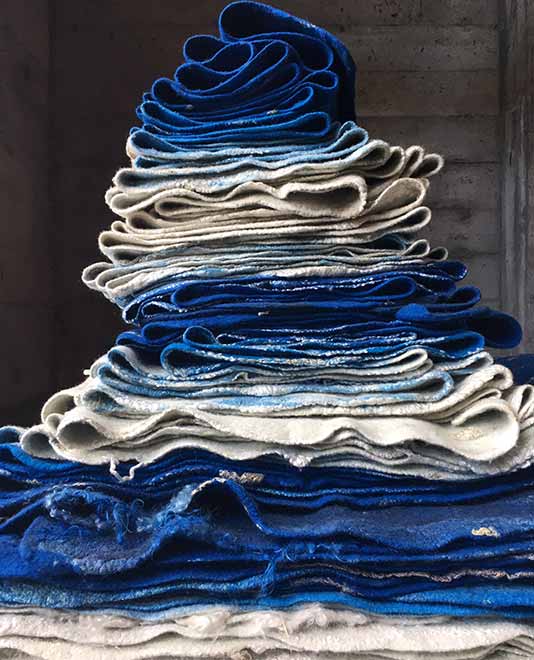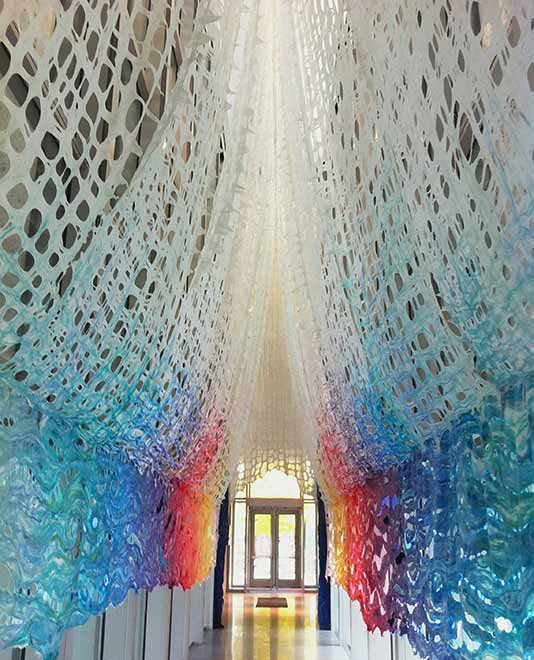Recent years has witnessed a seismic shift in the contemporary art landscape. Perhaps a reaction to the instantaneous nature of digital connectivity and the feelings of isolation it can evoke, or a natural evolution in the ebb and flow of artistic mediums, but where the turn of the millennium was dominated by video and experimental installation works, artists today are returning to more traditional, craft-based art practices. And with thanks to the tactile nature of the fibre, wool is playing a large part in the output of many contemporary artists, such as Sheila Hicks, Magda Sayeg, Claudy Jongstra and Hiromi Tango.
Having made it her mission to better understand felt – essentially a non-woven fabric from a raw fibre – artist Janice Arnold has travelled the world, working with nomadic tribes in Central Asia and Mongolia, to expand the possibilities of her practice. The resultant works are large site-specific installations marked by their encompassing, tactile quality – a tent-like structure, inspired by the yurt of Turkic-Mongolian tribes, for the Smithsonian Cooper-Hewitt National Design Museum, for example, or a cavernous passage of vertical felt strands, for the Grand Rapids Art Museum.
“With thanks to the tactile nature of the fibre, wool is playing a large part in the output of many contemporary artists.”
Inspiration, says the artist, comes from a number of elements: the raw, organic materials, historic process, and the natural world. “It is my artistic passion to take the ancient art form of felt-making and blend it with a modern aesthetic to create art and textiles that transcend time, looking both modern and ancient,” explains Arnold. “The current high-tech world, with its synthetic surroundings, has taken us far from the natural world and making things by hand. We are starved for natural textures, fibres and irregular forms. I believe wool felt connects us with our natural history in a way no other fabric can.”

Folded Time, sculptural installation piece for FELT DeCoded.
Arnold will again be the subject of an exhibition when FELT DeCoded | Wool: Nature’s Technology opens at the Museum of Craft and Design in San Francisco this February – a visual exploration of art and science that offers an intimate perspective of wool as nature’s own technology. “We are witnessing an increase in traditional handcrafts making a comeback in modern art,” says Stuart McCullough, the managing director of The Woolmark Company, the exhibition’s sponsor. “Natural, versatile, innovative and above all luxurious, wool and particularly felt continue to be used in modern ways whilst paying tribute to the fibre’s traditional roots.”
“It is my artistic passion to take the ancient art form of felt-making and blend it with a modern aesthetic."

CHROMA Passage, 2010, Grand Rapids Art Museum.
A highlight of the exhibition, to be hung from the museum’s ceiling, is Monster Felt, created with the help of the Central Washington community of Tieton. It was made with 65 pounds of regional wool and alpaca fibres that were laid down, saturated with water and felted by the community, who were invited to walk and dance on top of the wool to start the felting process. The piece was then dried, rolled up and kept for a year. Over the course of three years, volunteers and community members would hold events involving the Monster Felt. After three years of community effort overseen by Arnold, Monster Felt is believed to be the largest piece of contemporary hand-made felt in the world made in the traditional nomadic way.
FELT DeCoded | Wool: Nature’s Technology will be on display at the Museum of Craft and Design, San Francisco, from 11 February until 04 June 2017.